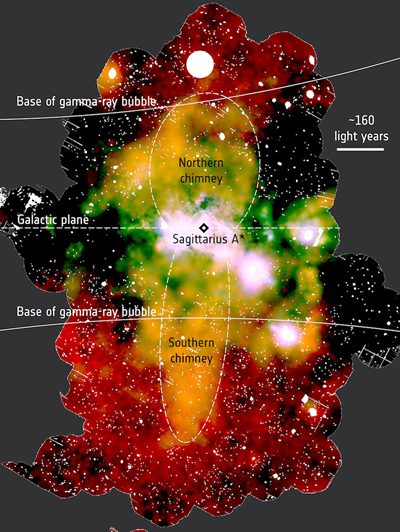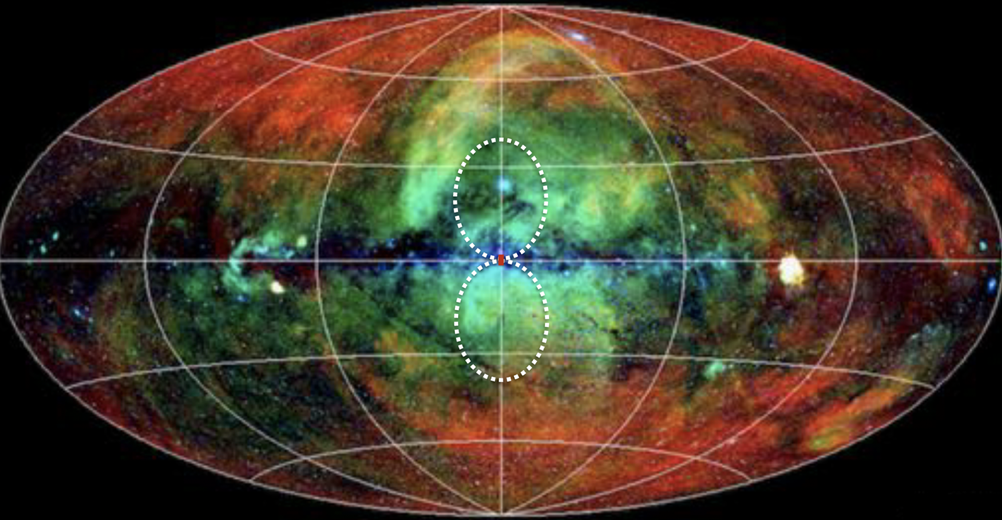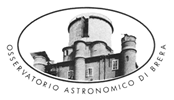
Click on the image to see our survey in high resolution.
Fig. 1: An X-ray view of the centre of our Milky Way galaxy, where the supermassive black hole Sagittarius A* is hosted. This image shows the temperature of the X-ray emitting gas in this turbulent region, with cooler regions shown in red and hotter regions in green and blue. The yellow-orange features streaming above and below the centre are two colossal "chimneys", extending hundreds of light-years each, that funnel material from the Galactic centre into two huge cosmic bubbles (more info and images: XMM-Newton’s view of the Galactic Centre). Copyright: ESA/XMM-Newton/G. Ponti et al. 2019, Nature
|
We are at the start of a revolution in our understanding of the hot, X-ray emitting, plasma of the Milky Way.
The growth of galaxies in the local Universe critically depends on the interplay (via outflows and re-condensation) between the hot plasma with the other phases of the interstellar medium.
As a prototype for typical spiral galaxies, the Milky Way offers the unique opportunity to capture the important details of such feedback all the way from sub-parsec to galactic scales.
In the 90’s, the ROSAT all-sky X-ray maps (see Fig.2) confirmed the existence of a hot component of the inter-stellar medium, the Galactic corona. However, because of strong obscuration in the soft X-ray energy band, those maps have a limited horizon of ∼1 kpc (∼3000 light years) in the Galactic plane. Therefore, despite the fundamental role of the hot phase of the inter-stellar medium, its properties are still basically unknown outside the Solar neighbourhood.
Our recent XMM-Newton survey (see Fig. 1) of the Galactic center demonstrates that the hot phase of the interstellar medium can be traced throughout the disc in the harder X-ray band, whenever deep and sensitive X-ray observations are available. Additionally, they probe the strong link between the energetic activity at the Galactic center and the Galactic corona. Besides, the hot plasma is a plausible candidate for containing the missing Galactic baryons and a key ingredient for galaxy evolution. However, so far less than ∼0.1% of the Milky Way has been covered by the narrow fields of view of current X-ray imaging telescopes (comparable to the extent of our survey of the Galactic center, see Fig.1).
The eROSITA all-sky survey will rectify this state of affairs. The Hot Milk project aims at tracing the connection and feedback between the Galactic corona and halo with the energetic activity at the Galactic center (e.g., due to cosmic rays, stellar and AGN outflows). This will represent one to two orders of magnitude improvements in sensitivity and/or coverage, compared to current surveys.
Hot Milk will produce sensitive X-ray maps which will represent an invaluable legacy for future multi-wavelength studies with current and next generation array instruments.
|

Click on the image to see ROSAT all-sky map in high resolution.
Fig. 2: ROSAT all-sky map of the soft X-ray diffuse emission, after removal of the point sources, in Galactic coordinates. In red, green and blue are shown the 0.1-0.4, 0.5-0.9 and 0.9-2.0 keV energy bands, respectively (see Freyberg & Egger 1999).
The white dashed ellipses indicate the approximate extension of the X-ray counterparts of the Fermi bubbles. The tiny red rectangle at the centre indicates the extension of the largest XMM+Chandra Galactic center survey (see Fig. 1). eROSITA will allow us to extend the study of the hot plasma (currently limited to the central few degrees) to the entire Milky Way.
|







